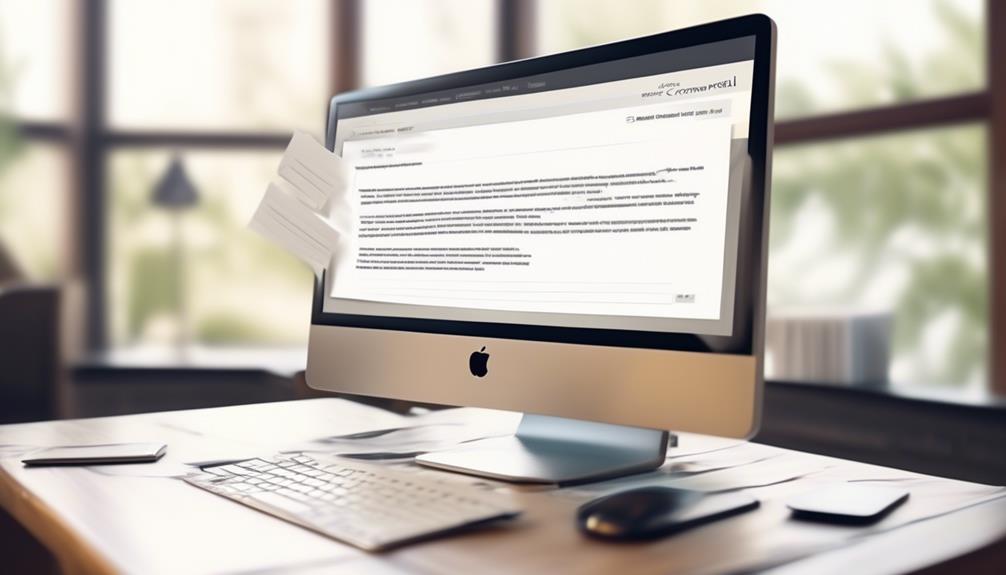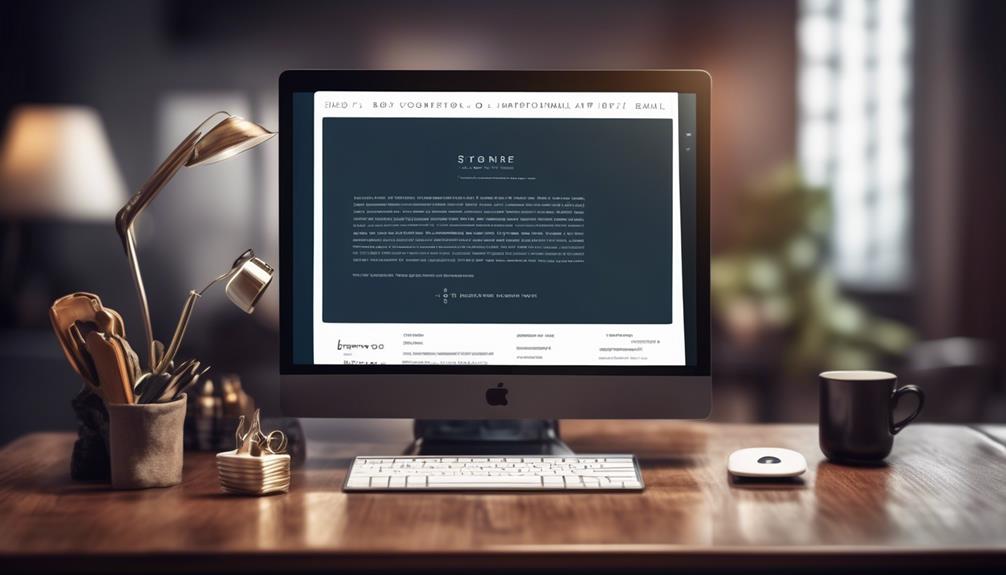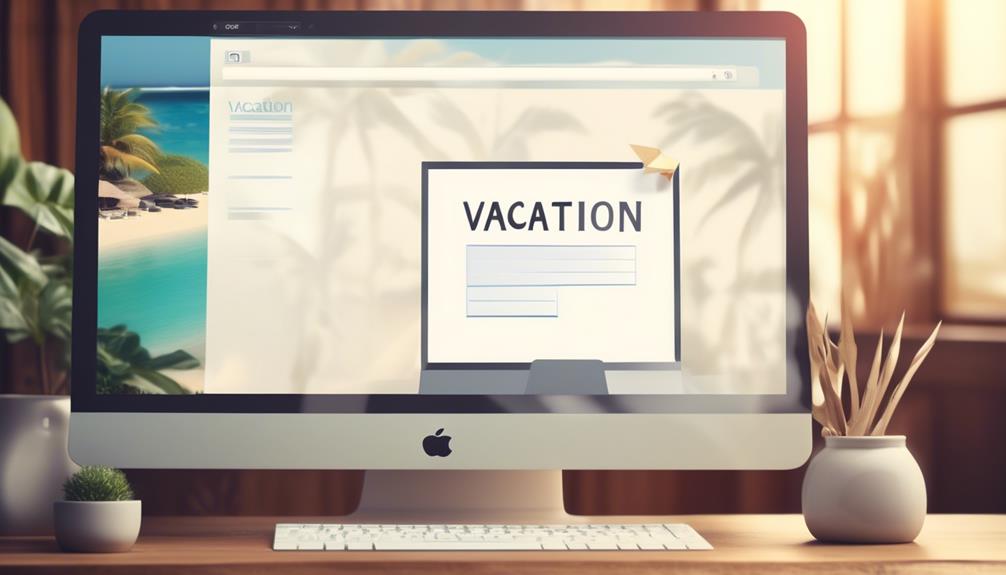We recognize that composing an email to correct an error may often seem akin to acknowledging a fault, which can be disconcerting. Nevertheless, it’s imperative to handle these instances with openness and professionalism.
In our experience, finding the right balance of empathy and accountability is key to maintaining a positive relationship with the recipient. So, how do we strike that balance to ensure our correction emails are effective and well-received?
Well, let's dive into the essential elements and best practices that can help us navigate this delicate task.
Key Takeaways
- Correction emails are important in maintaining professionalism and preventing confusion in business communication.
- Correction emails demonstrate commitment to accuracy and credibility, as well as respect for recipients by addressing and rectifying mistakes.
- Key elements of a correction email include a clear and concise subject line, prompt acknowledgment of the error, professional and courteous tone, offering solutions and support, and maintaining a positive relationship with the recipient.
- Effective subject lines for correction emails should use concise and straightforward language, focus on clarity and precision, and ensure the recipient understands the purpose of the email.
Understanding the Importance of Correction Emails
Understanding the importance of correction emails is essential for maintaining professionalism and preventing confusion in business communication. When an error occurs in an email, sending a correction email promptly is crucial. It not only demonstrates our commitment to accuracy and credibility but also shows respect for the recipients by addressing and rectifying mistakes. By sending a correction email, we uphold best practices in professional communication, contributing to customer satisfaction and trust.
Crafting a clear and concise subject line for a correction email is vital. It captures the recipients' attention and conveys the purpose of the email upfront. This helps to ensure that the correction email is noticed and acted upon promptly.
Additionally, before sending a correction email, it's important to assess the gravity of the mistake. Understanding the severity of the error allows us to tailor the tone and content of the email appropriately. Whether it's a minor typo or a significant error that could impact revenue, sending a correction email showcases our dedication to accuracy and professionalism.
Key Elements of a Correction Email

Crafting a correction email requires attention to detail and a thoughtful approach to addressing mistakes professionally. When sending correction emails, it's essential to include key elements to ensure effective communication and maintain a professional and courteous tone.
Here are the essential components of a correction email:
- Clear and Concise Subject Line: The email subject should clearly indicate that it's a correction email. Including relevant information in the subject line can help the recipient understand the nature of the email at a glance.
- Acknowledgment of Error: Promptly acknowledging the mistake and highlighting the error within the email demonstrates honesty and sincerity. This helps to build trust with the recipient and shows that the sender takes responsibility for their mistakes.
- Professional and Courteous Tone: Maintaining a polite and professional tone throughout the email is crucial. Even when addressing errors, it's important to be empathetic and considerate in the language used.
- Offering Solutions and Support: Providing a solution to rectify the error and offering support if needed can reassure the recipient. This demonstrates a commitment to resolving the issue and maintaining a positive relationship.
Crafting Effective Subject Lines
After acknowledging the mistake in the email, it's crucial to craft a subject line that clearly communicates the purpose of the correction without using negative or apologetic language.
When crafting effective subject lines for a correction email, it's essential to use concise and straightforward language to indicate that the email contains a correction to a previous message. The subject line should avoid negative or apologetic words and instead focus on clarity and precision.
In email marketing, the subject line is the first thing recipients see, so it's crucial to make it compelling to increase the likelihood of the email being opened. Balancing brevity with providing enough information in the subject line is important to convey the purpose of the correction email effectively.
Common mistakes in crafting subject lines for correction emails include being too vague or overly apologetic, which can diminish the professional tone of the email. Therefore, when sending the correction, a subject line that's clear, concise, and free of negative language is an important part of ensuring that the recipient understands the purpose of the email.
Sample Correction Email Templates

We are providing a selection of sample correction email templates to assist you in effectively addressing and rectifying mistakes made in previous communications. These templates can be customized to fit your specific situation and ensure that the correction email is professional and courteous.
When crafting a correction email, it's important to acknowledge the mistake and apologize for any inconvenience caused. Take responsibility for the error and provide a clear solution to rectify the mistake.
Ensure that the subject line clearly indicates it's a correction email and includes relevant information to catch the recipient's attention. Maintain a professional and empathetic tone in the email and use the first few words as the preview text, which is the first thing recipients see.
Additionally, if you're sending marketing emails, make sure to correct any spelling or minor grammar errors to maintain a good impression.
Lastly, outline the next steps to solve the problem and offer support if needed, ensuring the recipient feels valued and supported.
Best Practices for Sending Correction Emails
When addressing a mistake in previous communications, it's essential to adhere to best practices for sending correction emails to ensure a professional and courteous approach. Here are some best practices for sending correction emails:
| Best Practices | Description | Example |
|---|---|---|
| Acknowledge the mistake | Clearly admit to the error and apologize for any inconvenience caused | "We apologize for the incorrect invoice sent earlier." |
| Take responsibility | Show accountability and provide a clear solution to rectify the error | "We will issue a corrected invoice within 24 hours." |
| Outline next steps | Clearly outline the next steps to solve the problem and offer support if needed | "Please review the corrected invoice and let us know if you need any further assistance." |
| Be polite and professional | Maintain a courteous and professional tone throughout the email | "We appreciate your understanding and cooperation in this matter." |
When sending an email correcting a mistake in a particular program or service, it's crucial to follow the best course of action. Start by addressing the mistake, providing a solution, and offering support. It's important to ensure that all required fields are filled out correctly and that the email is sent promptly, especially if the correction is urgent. Additionally, be prepared to handle any negative feedback that may arise and always remember to apologize sincerely for the inconvenience caused.
Frequently Asked Questions
How Do You Write a Correction Email Sample?
We write correction emails by acknowledging the mistake, providing correct information, and expressing understanding. It's important to be clear, concise, and empathetic.
Acknowledge the error, explain the correction without dwelling on the mistake, and offer assistance if needed. Keep the tone professional and respectful, and always proofread before sending.
Accuracy and sincerity are key to maintaining trust and credibility with the recipient.
How Do You Send a Professional Correction Email?
We send a professional correction email by:
- Acknowledging the mistake
- Apologizing sincerely
- Offering a clear solution
It's important to be polite, professional, and supportive in our tone. Using a subject line that clearly indicates it's a correction email helps set the right expectations.
How Do You Write an Email if You Made a Mistake?
We approach the situation with transparency and accountability. We acknowledge the mistake, apologize sincerely, and propose a solution. Our aim is to rectify the error promptly and outline the next steps to resolve the issue.
We ensure the subject line clearly indicates it's a correction email and maintain a professional and courteous tone. We take full responsibility, avoid blaming others, and offer support if needed.
How Do You Write a Letter of Correction?
When writing a letter of correction, we acknowledge the mistake, apologize, take responsibility, provide a solution, and outline next steps.
We maintain a polite and professional tone, emphasize urgency if necessary, and directly point out the mistake.
Using subject lines that indicate a correction email and including relevant information is important.
It's crucial to have a plan for error correction emails and to be selective in sending them to avoid negative impact on customer satisfaction.
Conclusion
We understand that mistakes happen, and we appreciate your patience and understanding.
We're working diligently to rectify the error and prevent it from happening again in the future.
Your satisfaction is our top priority, and we want to ensure that you receive the exceptional service you deserve.
Thank you for your continued support and trust in our brand.










